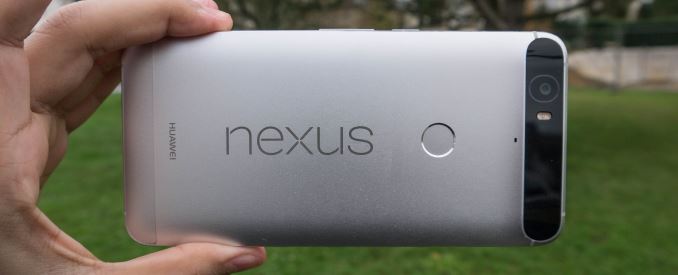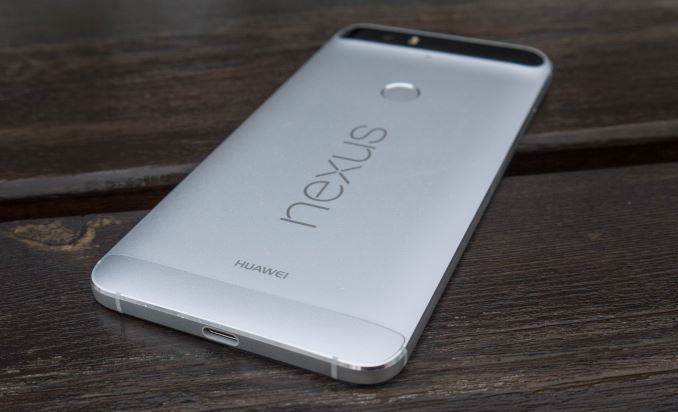The Google Nexus 6P Review
by Andrei Frumusanu on December 16, 2015 8:00 AM ESTFinal Words
As we reach the conclusion of our Nexus 6P review, we’re hopefully left with a more educated view of how the 6P performs and why it perform as it does. It’s also the first showing from Huawei as a Nexus partner, and I think that Huawei has proven itself to be an extremely competent partner at that.
Design-wise, the Nexus 6P takes advantages of Huawei’s experience in building aluminium uni-body phones which results in an extremely solidly built device. While the front face of the phone doesn’t have too much character to it due it being little more than an all-black glass surface with screen and the two speaker grills, it’s the back that makes the Nexus 6P to be instantly recognizable. The “visor” as people have come to call it serves both as an aesthetic feature as well as a practical one as it houses the camera system and flash.
The metal finish and polish makes for a solid grip that is helped by the comparatively flatter sides of the device. Here the 6P trades in a bit of in-hand feel for better handling of the large form-factor. And make no mistake as the Nexus 6P is very much a large form-factor phablet device. The 5.7” screen compares to competing devices such as the Note 5 or the Mi Note Pro, however the 6P is noticeably larger than its cousins due to larger bezels both on the sides and especially on the top and bottom.
The large screen is backed by an excellent AMOLED panel from Samsung. Here Google seems to have made a much better choice in panels than what we saw in last year’s Nexus 6 or what Huawei seems to have employed in their own Mate S. Picture quality is comparable to the Note 5, although the 6P loses out in terms of efficiency, only able to slightly beat the Note 4’s screen efficiency.
Performance wise, the Nexus 6P is excellent. Huawei’s internal design and handling of the SoC’s thermal dissipation makes this the best implementation of Qualcomm’s Snapdragon 810 SoC. CPU performance is currently among one of the best, particularly in bursty workloads, although it can’t really match the sustained and consistent performance of Samsung’s Exynos 7420 devices or even last year’s Snapdragon 801/805 phones. Gaming performs well too, although we again see that sustained performance is only about half of peak performance, an issue competing high-end Android devices also have to deal with.
Battery life, while being subjectively is very good to the point that no user would have to complain about it, it still falls behind the competition. I’ll be honest and say that 2015 has been a pretty bad year for Android devices, as other than Samsung, vendors had to rely on the Snapdragon 810/808’s rather disappointing power efficiency. It’s the fact that you know that a device could have done much better had it had a different SoC that simply leaves me hesitant in praising the Nexus 6P’s battery life. It reminds me of Huawei’s own Mate 7, which while it had excellent battery life due to the very large battery capacity, it failed to be able to provide results worthy able to live up to the specifications.
Meanwhile the camera on the Nexus 6P is among the best, although there were some software processing and consistency issues discovered. Due to these issues encountered in my testing I’m a bit undecided on how to evaluate the 6P’s camera. In situations where it manages to perform, it performs excellently. But as we’ve seen there’s also scenarios where it struggles to get good exposure, and I view that as more important than having an edge in sharpness and effective spacial resolution. And an edge in sharpness is something the Nexus 6P very much has. While the Nexus 6P’s daylight performance can be argued about, it absolutely seems to lead in low-light scenarios as the camera sensor is able to resolve that much more details than the competition; as long as it exposes and color-balances correctly (most of the time).
Wrapping things up, we’re left with the question of the Nexus 6P is a worthwhile buy or not. Here I’d like to offer two conclusions, one for US users and one for buyers in Europe and the rest of the world. At a US price starting at $499 for an unlocked variant, it seems that the Nexus 6P hits a sweet-spot in terms of price-performance and is able to position itself very competitively against other devices. Google’s own services are also much more prevalent and far reaching in North America, so there’s definitely advantage of having a pure Nexus experience (Along with the non-carrier firmware advantage). Here the Nexus 6P is definitely a worthwhile purchase.
For regions outside of North America, and Europe especially, the Nexus 6P just seems an unreasonable device. Starting at prices from 649€, you would expect a device without drawbacks, and it’s simply not worth the premium over other devices, or at the same price you’ll be better off with an equally priced S6 Edge+ or Note 5 if it’s available in your region. Here, the Nexus 6P just simply doesn’t seem that attractive unless you’re putting a lot of weight into the Google Nexus experience, which I find to be a rather subjective aspect of the device. With Snapdragon 820 phones coming in just a few months there’s also the viable option to hold out for better alternatives as we're on the verge of a large generational jump that will undoubtedly bring a lot of improvements to the table.












219 Comments
View All Comments
tipoo - Wednesday, December 16, 2015 - link
What was tin hat about that?3DoubleD - Wednesday, December 16, 2015 - link
The problem of competing against the 6S is that Apple was the first to produce a custom 64-bit SoC design on 16 nm FF. Samsung released the first 16 nm FF design, but did so nearly a year ago with a stock BIG.little configuration. They saw massive gains in efficiency purely from the impressive operating voltage and leakage improvements that FF transistors provide. No one else has had access to 16 nm FF until Apple released their 16 nm FF custom SoC. It completely dominates the stock ARM non-16 nm FF SoCs due to design and process advantage and handily beats Samsung's 16 nm FF stock ARM SoC on better design alone.No manufacturer outside of Samsung has the ability to compete with Apple on this level (bleeding edge manufacturing and SoC design), but I can't say Samsung really dropped the ball either. This year's Exynos was plenty fast and efficient to sell premium devices and it performed well against the iPhone 6, which it was in competition with. If only they didn't drop the ball with the small battery capacity they could have had a killer phone.
Next year Samsung won't have the luxury of being the only player with 16 nm FF on Android, so they'll need to step up their game with SoC design, but I don't actually think beating Apple's SoC performance is very important for selling phones. The S6 had great SoC performance and it wasn't an astounding sales success. Thankfully, with 16 nm FF going mainstream next year the rest of us will have access to much more efficient SoCs, even if SoC design continues to stagnate, without the premium price gouging from Apple or Samsung.
grayson_carr - Wednesday, December 16, 2015 - link
Does the benchmark performance of A9 really translate to an improved real world experience though? I still notice that a lot of animations, like the 3D touch menu popping up on the home screen and the app switcher, run at a low framerate on the iPhone 6S Plus (the 6S is much smoother, but it also has a pretty low res screen for 2015). And to me browsing and switching between apps on an iPhone 6S Plus doesn't feel any faster than it does on a Nexus 6P.amdwilliam1985 - Thursday, December 17, 2015 - link
Got a friend who traded in 6+ to 6S+ because he can't handled the lag of iOS9.x, lol, he must be mad...Lavkesh - Thursday, December 17, 2015 - link
The lag has been taken care in the latest release iOS 9.2Djdjndjddjs - Wednesday, December 16, 2015 - link
Subpar hardware? Android has double the screen resolution and a pixel density over 100 pixels better. Then there's the fact they offer more memory at a better price and have better cameras. Saying that the iPhone is better when it still only has a 1080p LCD screen is just ignorant.johnnycanadian - Thursday, December 17, 2015 - link
Heh. Screen resolution? Certainly. More memory? Sure, Android still isn't optimized to the level that iOS is, so it needs it. 2GB is an absolute minimum for 5.x, IMHO. Cameras? Not so much; at best it's a toss-up. And SoC? There's virtually no comparison (the Note5 is the only one that comes close). So yeah, sub-par hardware. I suppose I should have written "Sub-par operating environment" so the OS issues (bloated, unoptimized code) and the less-than-stellar SoC performance would both be taken into account.I'd LOVE to go Android, but until the operating environment can match iOS' I'm stuck with Apple.
grayson_carr - Thursday, December 17, 2015 - link
"2GB is an absolute minimum for 5.x"Is it? My grandmother's Moto G 2015 with only 1 GB of RAM runs great and it's on Android 5.1.
TheinsanegamerN - Monday, December 21, 2015 - link
sending texts and calling her grandchildren are not very demanding. try to browse big websites or play games and that phone will slow to a crawl.tipoo - Tuesday, December 22, 2015 - link
Does your grandmother multitask as much as younger smartphone users? Genuine question. I had a first gen Moto G, I liked it, but the 1GB RAM really started bothering me with every app flip taking time. The third gen one can come with 2GB on the 16GB model, thankfully.On my 6S now, I can't complain about it's 2GB RAM much at all, the only things that reload are usually hours stale anyways.